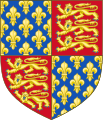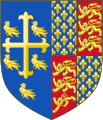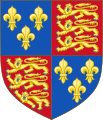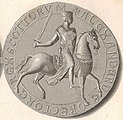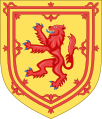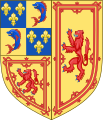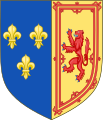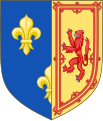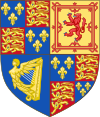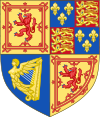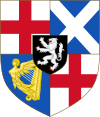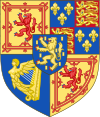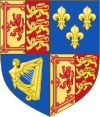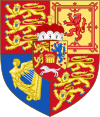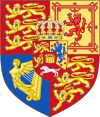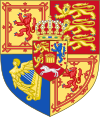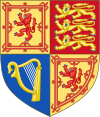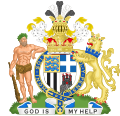User:Ebonelm/sandbox
| Royal coat of arms of the United Kingdom | |
|---|---|
 | |
| Versions | |
 | |
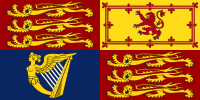 The banner of arms, which serves as a royal standard | |
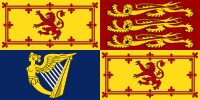 The banner of arms, which serves as a royal standard in Scotland | |
 English Officer of Arms's tabard | |
| Armiger | King Charles III in right of the Crown |
| Adopted | 1837 |
| Crest | Upon the helm, a royal crown proper thereon a lion statant guardant Or langued Gules armed Argent, royally crowned Proper; mantled Or doubled Ermine |
| Shield | Quarterly, I and IV Gules, three lions passant guardant in pale Or langued and armed Azure. II Or a lion rampant Gules armed and langued Azure within a double tressure flory-counter-flory Gules. III Azure a harp Or stringed Argent.; quarters for England and Scotland are exchanged in Scotland. |
| Supporters | On the dexter a lion rampant guardant Or langued and armed Gules, royally crowned Proper. On the sinister a Unicorn rampant Argent armed crined and unguled Or, and gorged with a Coronet composed of crosses patee and fleurs-de-lis, a chain affixed thereto passing through the forelegs and reflexed over the back Or |
| Compartment | Tudor rose, Shamrock, and Thistle |
| Motto | French: Dieu et mon droit, lit. 'God and my right' |
| Order(s) | Order of the Garter Order of the Thistle (Scottish version) |
| Earlier version(s) | see below |
| Use | On all Acts of Parliament; the cover of all UK passports; various government departments; adapted for the reverse of coins of the pound sterling (2008) |
The royal coat of arms of the United Kingdom, or the royal arms for short, is the arms of dominion of the British monarch,[1][2] currently King Charles III. These arms are used by the King in his official capacity as monarch of the United Kingdom. Variants of the royal arms are used by other members of the British royal family, by the Government of the United Kingdom in connection with the administration and government of the country, and some courts and legislatures in a number of Commonwealth realms. A Scottish version of the royal arms is used in and for Scotland. The arms in banner form serve as basis for the monarch's official flag, the Royal Standard.
In the standard variant used outside of Scotland, the shield is quartered, depicting in the first and fourth quarters the three passant guardant lions of England; in the second, the rampant lion and double tressure flory-counterflory of Scotland; and in the third, a harp for Ireland.[3] The crest is a statant guardant lion wearing the Tudor Crown, himself on another representation of that crown. The dexter supporter is a likewise crowned English lion; the sinister, a Scottish unicorn. The English and Scottish quarters and supporters are swapped in the Scottish version of the arms.
In the greenery below, a thistle, Tudor rose and shamrock are depicted, representing Scotland, England and Ireland respectively. This armorial achievement comprises the motto, in French, of English monarchs, Dieu et mon droit (God and my right), which has descended to the present royal family as well as the Garter circlet which surrounds the shield, inscribed with the Order's motto, in French, Honi soit qui mal y pense (Shame on him who thinks evil of it). In the arms as used in Scotland, the Order of the Thistle's motto, Nemo me impune lacessit (No one provokes me with impunity) is used. The official blazon of the royal arms is:
Quarterly, first and fourth Gules three Lions passant gardant in pale Or armed and langued Azure (for England), second quarter Or a Lion rampant within a double tressure flory-counter-flory Gules (for Scotland), third quarter Azure a Harp Or stringed Argent (for Ireland), the whole surrounded by the Garter; for a Crest, upon the Royal helm the Imperial Crown Proper, thereon a Lion statant gardant Or imperially crowned Proper; Mantling Or and Ermine; for Supporters, dexter a Lion rampant gardant Or crowned as the Crest, sinister a Unicorn Argent armed, crined and unguled Proper, gorged with a Coronet Or composed of Crosses patées and Fleurs-de-lis a Chain affixed thereto passing between the forelegs and reflexed over the back also Or. Motto Dieu et mon Droit in the compartment below the shield, with the Union Rose, Shamrock and Thistle engrafted on the same stem.[3]
Following the death of Queen Elizabeth II, the design of King Charles III's royal cypher was announced on 27 September 2022, which featured the Tudor crown rather than the St Edward's Crown. According to the College of Arms, the Tudor crown will now be used in representations of the Royal Arms.[4]
Uses[edit]
The royal arms appear in courtrooms, since the monarch is deemed to be the fount of judicial authority in the United Kingdom and law courts comprise part of the ancient royal court (thus so named).[5] Judges are officially Crown representatives, demonstrated by the display of the royal arms behind the judge's bench in courts in England and Wales; which notable exceptions include the Supreme Court of the United Kingdom, which displays its own badge and flag to symbolize its nationwide role, the magistrates' court in the City of London, where behind the justices of the peace stands a sword upright flanked by the arms of the City and the Crown. In addition, the royal arms cannot be displayed in courtrooms or on court-house exteriors in Northern Ireland, except for the courtrooms of the Royal Courts of Justice in Belfast and the courts in Armagh, Banbridge, Downpatrick, Magherafelt, or Omagh, and the exterior of court buildings that had them in place prior to the 2002 law.[6]
As the United Kingdom is governed in the monarch's name, the British government also uses the royal arms as a national symbol of the United Kingdom,[7] and, in that capacity, the coat of arms can be seen on several government documents and forms, passports, in the entrance to embassies and consulates, etc. However, when used by the government and not by the monarch personally, the coat of arms is often represented without the helm. This is the case with both the Scottish and non-Scottish versions.

The royal arms have regularly appeared on the coinage produced by the Royal Mint including, for example, from 1663, the Guinea and, from 1983, the British one pound coin. In 2008, a new series of designs for all seven coins of £1 and below was unveiled by the Royal Mint, every one of which is drawn from the royal arms. The full royal arms appear on the one pound coin, and sections appear on each of the other six, such that they can be put together like a puzzle to make another complete representation of the royal arms.[8] The series was replaced in 2016 by the Nations of the Crown bi-metallic coin.
The monarch grants royal warrants to select businesses and tradespeople which supply the Royal Household with goods or services. This entitles those businesses to display the royal arms on their packaging and stationery by way of advertising.
It is customary (but not mandatory) for churches throughout the United Kingdom whether in the Church of England or the Church of Scotland to display the royal arms to show loyalty to the Crown.[9][10] If a church building of either denomination does not have a royal arms, permission from the Crown must be given before one can be used.[11]
A banner of the royal arms, known as the Royal Standard, is flown from the royal palaces when the monarch is in residence, Windsor Castle and Buckingham Palace being principal abodes; and from public buildings only when the monarch is present. For instance, the Royal Standard only flies over the Palace of Westminster when the monarch is delivering the speech from the throne in the House of Lords at the State Opening of Parliament. This protocol equally applies to the monarch's principal residences in Scotland (the Palace of Holyroodhouse and Balmoral Castle), where the Royal Standard (Scottish version) is flown. When the monarch is not in residence the Union Flag, or in Scotland the ancient Royal Standard of Scotland, is flown.
The widely sold British newspaper The Times uses the Hanoverian royal arms as a logo, whereas its sister publication, The Sunday Times, displays the current version. Likewise, the Australian newspaper The Age and the New Zealand newspaper, The Press, uses the insignia as their logo.
The royal arms are also displayed in all courts in British Columbia, as well as in other Canadian provinces such as Ontario, where the judges are appointed by Crown authority.[12] In Australia they were also displayed by all viceroys as representation of their Crown authority, and by most state supreme courts across the country. Additionally the Western Australian Legislative Council has also adopted them as its own symbol.[citation needed]
The royal arms were controversially used by former Prime Minister Margaret Thatcher as her official letterhead from c. 1997.[13]
Scotland[edit]

Since the Union of the Crowns in 1603, a separate version of the royal arms has been used in Scotland, giving the Scottish elements pride of place.
The shield is quartered, depicting in the first and fourth quarters the lion rampant of Scotland; in the second, the three lions passant guardant of England; and in the third, the harp of Ireland.
The crest atop the Crown of Scotland is a red lion, seated and forward facing, itself wearing the Crown of Scotland and holding the two remaining elements of the Honours of Scotland, namely the Sword of State and the Sceptre of Scotland. This was also the crest used in the royal arms of the Kingdom of Scotland. The slogan, in Scots, appears above the crest, in the tradition of Scottish heraldry, and is an abbreviated form of the full motto: In My Defens God Me Defend.
The supporters change sides and both appear wearing the crowns of their respective Kingdom. The dexter supporter is a crowned and chained unicorn, symbolising Scotland. The sinister supporter is a crowned lion, symbolising England. Between each supporter and the shield is a lance displaying the flag of their respective Kingdom.
The coat also features both the motto Nemo me impune lacessit (No one wounds (touches) me with impunity) and, surrounding the shield, the collar of the Order of the Thistle. On the compartment are a number of thistles, Scotland's national flower.
England, Wales and Northern Ireland[edit]

Unlike the Acts of Union 1707 with Scotland, the Acts of Union 1800 with Ireland did not provide for a separate Irish version of the royal arms.[dubious ] The crest of the Kingdom of Ireland ("on a wreath Or and Azure, a tower triple-towered of the First, from the portal a hart springing Argent attired and unguled Or") has had little or no official use since the union.
The harp quarter of the royal arms represents Ireland on both the English and Scottish versions. Likewise, one English quarter is retained in the Scottish version, and one Scottish quarter is retained in the English version. Thus, England, Scotland and Ireland are represented in all versions of the royal arms since they came under one monarch. When the Irish Free State established its own diplomatic seals in the 1930s, the royal arms appearing on them varied from those on their UK equivalents by having the Irish arms in two-quarters and the English arms in one.[14]
By contrast, there is no representation at all for Wales in the royal arms, as at the Act of Union 1707 Wales was an integral part of the Kingdom of England pursuant to the Laws in Wales Acts 1535 and 1542; thus, it has been argued Wales is represented in the English coat of arms. However the argument is somewhat disingenuous as in 1535 the Welsh Dragon was already part of the Tudor Coat of Arms. Upon the accession of the Tudor monarchs, who were themselves of Welsh descent, a Welsh Dragon was used as a supporter on the royal arms. This was dropped by their successors, the Scottish House of Stuart, who replaced the Tudors' dragon supporter with the Scottish unicorn.
In the 20th century, the arms of the principality of Wales were added as an inescutcheon to the coat of arms of the Prince of Wales, and a banner of those arms with a green inescutcheon bearing the prince's crown is flown as his personal standard in Wales. The so-called Prince of Wales's feathers are a heraldic badge rather than a coat of arms upon a shield, but they are not Welsh in any case. They derive, in fact, from the English Princes of Wales (who may owe them to an exploit of Edward, the Black Prince at the Battle of Crécy) and carry the motto Ich dien (German, "I Serve"). In any event, they do not form part of the royal arms, as opposed to the heraldic achievement of the Prince of Wales, who drops them upon his accession as king.
History[edit]
Kingdoms of England and Scotland[edit]
The current royal arms are a combination of the arms of the former kingdoms that make up the United Kingdom, and can be traced back to the first arms of the kings of England and kings of Scotland. Various alterations occurred over the years as the arms of other realms acquired or claimed by the kings were added to the royal arms. The table below tracks the changes in the royal arms from the original arms of King Richard I of England, and William I, King of Scots.
|
Union of the Crowns and the Commonwealth[edit]
| The Union of the Crowns places England, Ireland and Scotland under one monarch | ||
| Arms | Dates | Details |
|---|---|---|
| 1603–1649* | James VI, King of Scots, inherited the English and Irish thrones in 1603 (Union of the Crowns), and quartered the royal arms of England with those of Scotland. For the first time, the Royal Coat of Arms of Ireland was added to represent the Kingdom of Ireland.[3] The Scottish version differs in giving the Scottish elements precedence. *Use of the Scottish version, together with the monarchy under Charles II, continued in Scotland during the period 1649–1651. | |
| 1649–1654 |
These novel arms, already in use by parliamentarians in 1648, were adopted by the Commonwealth of England established in 1649.[19] | |
| 1654–1655 |
The Commonwealth of England, Scotland and Ireland (the Protectorate) was created in 1653. St Andrew's Cross was added to the arms in 1654.[20] | |
| 1655–1659 | The arms of the Commonwealth from 1655 to 1659. Struck in 1655, the Great Seal included the personal arms of Oliver Cromwell on a shield in the centre.[3]
Blazon: Quarterly 1 and 4 Argent a Cross Gules (England) 2 Azure a Saltire Argent (Scotland) and 3 Azure a Harp Or Stringed Argent (Ireland) on an Inescutcheon Sable a Lion Rampant Argent (Cromwell's arms). The supporters were a crowned lion of England and a red dragon of Wales. The Scottish unicorn was removed, as it was associated with the Stuart Monarchy. The motto read PAX QUÆRITUR BELLO ("peace is obtained through war").[21] | |
| 1659–1660 |
Following the Protectorate, the 1654 arms were restored. | |
| 1660–1689 | Charles II restored the royal arms following the restoration after the civil wars. | |
| 1689–1694 | King James II & VII is deposed and replaced with his daughter Mary II and her husband, William III. As King and Queen they impaled their arms: William bore the royal arms with an escutcheon of Nassau (the royal house to which William belonged) added (a golden lion rampant on a blue field with golden billets), while Mary bore the royal arms undifferenced.[22][23] | |
| 1694–1702 | After the death of Mary II, William III reigned alone, and used his arms only.[3][22] | |
| 1702–1707 | Queen Anne inherited the throne upon the death of King William III & II, and the royal arms returned to the 1603 version.[3] | |
After the Acts of Union 1707[edit]
| At the Union creating Great Britain in 1707, arms were adopted for the new kingdom, and again in 1801 at the Union creating the United Kingdom | ||
| Arms | Dates | Details |
|---|---|---|
| 1707–1714 | Wikimedia Commons has media related to Coats of arms of Queen Anne of Great Britain. | |
| 1714–1800 | Wikimedia Commons has media related to | |
| 1801–1816 | Wikimedia Commons has media related to Coats of arms of King George III of the United Kingdom. | |
| 1816–1837 | Wikimedia Commons has media related to | |
| 1837–present | Wikimedia Commons has media related to Coats of arms of Queen Victoria of the United Kingdom. Depictions of the harp having varied between a simple version of the Gaelic harp (as shown here) and a more elaborate version featuring a head and breast of a winged maiden, traditionally the Maid of Erin, as the pillar. Historically the Maid of Erin harp was more prevalent and remains in use in the Royal Standard of the United Kingdom, however the plain version has recently been more commonly used in part because of the personal preference of Queen Elizabeth II.[24] | |
Blazon[edit]
Blazon[edit]
This table breaks down the official blazons to enable comparison of the differences between the general coat and the coat used in Scotland.
| Everywhere except Scotland | Scotland | |
|---|---|---|
| Quarterly I & IV | Gules three lions passant gardant in pale Or armed and langued Azure | Or a lion rampant Gules armed and langued Azure within a double tressure flory-counter-flory of the second |
| Quarterly II | Or a lion rampant Gules armed and langued Azure within a double tressure flory-counter-flory of the second | Gules three lions passant gardant in pale Or armed and langued Azure |
| Quarterly III | Azure a harp Or stringed Argent | |
| Surrounded by | The Garter circlet | The collar of the Order of the Thistle |
| Crest | Upon the Royal helm the imperial crown proper, thereon a lion statant gardant Or imperially crowned proper | Upon the Royal helm the crown of Scotland proper, thereon a lion sejant affronté Gules armed and langued Azure, Royally crowned proper holding in his dexter paw a sword and in his sinister a sceptre, both proper |
| Supporters | Dexter a lion rampant gardant Or imperially crowned proper, sinister a unicorn Argent, armed, crined and unguled Or, gorged with a coronet Or composed of crosses patée and fleurs de lis a chain affixed thereto passing between the forelegs and reflexed over the back also Or | Dexter a unicorn Argent Royally crowned proper, armed, crined and unguled Or, gorged with a coronet Or composed of crosses patée and fleurs de lis a chain affixed thereto passing between the forelegs and reflexed over the back also Or holding the standard of Saint Andrew, sinister a lion rampant gardant Or imperially crowned proper holding the standard of Saint George |
| Motto | Dieu et mon Droit (French) | In My Defens God Me Defend, abbr. In Defens (Scots) |
| Order Motto | Garter: Honi soit qui mal y pense (Old French) | Thistle: Nemo me impune lacessit (Latin) |
| Plants on the compartment | Roses, thistles and shamrocks (on the same stem) | Thistles only |
| Element | Description | Image |
|---|---|---|
| Crest | The coat of arms are surmounted by a rendition of Tudor Crown. This element represents the United Kingdom's status as a constitutional monarchy headed by a sovereign king or queen. This style of crown was that preferred by King Charles III and was changed in 20220 from St Edward's Crown which was used by Queen Elizabeth II. The crest is based on the Royal Crest of the United Kingdom but differenced by the addition of a maple leaf,[25] and symbolizes the sovereignty of Canada.[26] It appears on the flag of the Governor-General,[26] symbolizing that the Governor-General is a representative of the Sovereign. The crest consists of a crowned gold lion standing on a twisted wreath of red and white silk and holding a maple leaf in its right paw. |  |
| Helm | The arms show a royal helmet, which is a barred helm of gold embossed with a maple leaf design looking outward, with mantling of white and red, stylized in the official version to look like maple leaves.[27] | |
| Escutcheon | The escutcheon is divided into five sections.
The first division at the viewer's top left contains the three golden lions that have been a symbol of England since at least the reign of King Richard I.[28] The second quarter bears the red lion rampant of Scotland in a double treasure border with fleurs-de-lis, used as a symbol of Scotland since at least the reign of William I. The third quarter shows the Irish harp of Tara. The fourth quarter shows the Royal Banner of France or "Bourbon Flag" with three gold fleurs-de-lis on blue field arranged two and one, symbolizing royal France.[29] The fifth charge, a sprig of red maple leaves at the bottom, is a distinctly Canadian symbol that became gradually identified with the country throughout the 19th century.[30] The arrangement of three leaves on one sprig was first seen on a Saint-Jean-Baptiste Day poster in 1850.[31] They were first proposed as a symbol in 1834, were established in 1868 on the arms of Quebec and Ontario and officially became the national emblem in 1965, with the proclamation of the Flag of Canada.[27] Initially, the leaves were depicted as coloured green on the coat of arms because it was thought to represent youth, as opposed to the red colour of dying leaves in autumn.[25] However, they are blazoned as "proper", so could be shown as either red or green, and it is the blazon, rather than any depiction, which is regarded as authoritative.[32] The leaves were later redrawn in official depictions in 1957 with the current colour to be in line with the official colours of Canada. They are further stylized in that natural maple leaves do not grow in sprigs of three. Beginning in the 1960s, there developed an interpretation of the leaves as symbolic of Canadian multiculturalism; the country's different groups of people separate, but also joined together. There is, however, no record from the designing committee indicates there was any intention behind the particular arrangement of the leaves; the choice of three leaves appears to have been aesthetic.[31] The shield forms the basis of the royal standard of the United Kingdom.[33] |
 |
| Ribbon | The ribbon is marked desiderantes meliorem patriam, meaning "desiring a better country," which is the motto of the Order of Canada, taken from Hebrews 11:16. This component was added by the Queen in 1987 on the advice of her Prime Minister.[34] With the patriation of oversight of arms to Canada through the Canadian Heraldic Authority the following year,[35] the constitution of the Order of Canada was amended to include entitlement by all recipients to encircle their own arms with the ribbon if arms are granted to them.[36] Since 1994 the arms used by government ministers and institutions have slowly changed to reflect the new version with the ribbon.[25] |  |
| Motto | The motto of Canada is in Latin a mari usque ad mare (From sea to sea), a part of Psalm 72:8.[37] This phrase was suggested by Joseph Pope, then-Under Secretary of State, when the Arms were redesigned in 1921.[38] The motto was originally used in 1906 on the head of the mace of the Legislative Assembly of Saskatchewan.[37]
In March 2006, the premiers of Canada's three territories called for the amendment of the motto to better reflect the vast geographic nature of Canada's territory,[39] as Canada has coastlines on the Arctic, Atlantic, and Pacific Oceans. Two suggestions for a new motto are A mari ad mare ad mare (from sea to sea to sea) and A mari usque ad maria (from the sea to the other seas).[40][41] |
|
| Supporters | Supporting the shield on either side are the English lion and Scottish unicorn, which are also the supporters of the UK coat of arms.[38] The English lion[25] stands on the viewer's left and holds a gold-pointed silver lance flying the Royal Union Flag. The Scottish unicorn[25] has a gold horn, a gold mane, gold hooves, and around its neck a gold, chained coronet of crosses and fleurs-de-lis; it holds a lance flying a banner of royalist France, the three gold fleurs-de-lis on a blue background.[38] Unlike the British version, the lion is not crowned, nor is it facing the viewer. The broken chain on the unicorn symbolizes the unicorn's resistance to oppression.[25] |  |
| Compartment | The entire coat of arms rests on the compartment, which is made up of the floral emblems of the founding nations.[25] The Tudor rose is the floral badge of England and Wales, combining the White Rose of York and the Red Rose of Lancaster.[38] The thistle and shamrock are the symbols of Scotland and Ireland, respectively, while the fleur-de-lis has been the royal symbol of France since the 12th century.[38][42] |
Other variants[edit]
Royal family[edit]
Members of the British royal family are granted their own personal arms. In the past, the monarch's younger sons used various differences; and married daughters of the monarch impaled the plain royal arms with their husbands' arms. But for many centuries now, all members of the royal family have had differenced versions of the royal arms settled on them by royal warrant.[43] Only children and grandchildren in the male line of the monarch are entitled to arms in this fashion: the arms of children of the monarch are differenced with a three-point label; while grandchildren of the monarch are differenced with a five-point label. An exception is made for the eldest son of the Prince of Wales, who also bears a three-point label. The labels are always white (argent) and each prince or princess has individual marks to form his or her particular difference, except the Prince of Wales, who uses a plain white three-pointed label.[43] Since 1911, the arms of the Prince of Wales also displays an inescutcheon of the ancient arms of the Principality of Wales.[43]
Queens consort and the wives of sons of the monarch also have their own personal coat of arms. Typically this will be the arms of their husband impaled with their own personal arms or those of their father, if armigerous. However, the consorts of a queen regnant are not entitled to use the royal arms. Thus Prince Philip, Duke of Edinburgh was granted his own personal arms. A notable exception to this rule was Prince Albert, who used the royal arms (differenced by a special label) quartered with his own Saxon royal arms.[43]
Currently the following members of the royal family have their own arms based on the royal arms:
| Armorial achievement | Shield | Bearer | Difference(s) |
|---|---|---|---|

|
William, Prince of Wales, outside Scotland | The coat of arms of Edward VIII and Charles III as Prince of Wales was the arms of the United Kingdom with a white label of three points and an inescutcheon bearing the arms of Wales. | |

|

|
Prince William, Duke of Rothesay, in Scotland | Used in Scotland, the arms of the Duke of Rothesay are those of Clan Stewart of Appin adapted, namely the quartered arms of the Prince and Great Steward of Scotland and Lord of the Isles (secondary titles of the Duke) with an inescutcheon as Scottish heir apparent (the Royal Arms of Scotland with a blue three-point label). |

|
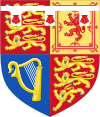
|
Prince Harry, Duke of Sussex | Five-point label with three red escallops in alternate points, alluding to the patrilineal arms of his mother, Diana, Princess of Wales. The College of Arms has stated that his label would change to one of three points, with each point bearing an escallop, upon his father's or brother's accession to the throne, which occurred in 2022.[44][45][46] |

|
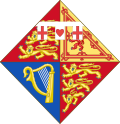
|
Anne, Princess Royal | Three-point label, the points bearing a red cross, a red heart and a red cross.[3] |

|
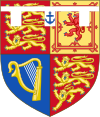
|
Prince Andrew, Duke of York | Three-point label, the centre point bearing a blue anchor.[3] |

|

|
Princess Beatrice, Mrs Edoardo Mapelli Mozzi | Five-point label with three bees in alternate points, alluding to the patrilineal arms of her mother, Sarah, Duchess of York. |

|
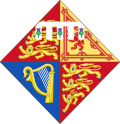
|
Princess Eugenie, Mrs Jack Brooksbank | Five-point label with three thistles in alternate points, alluding to the patrilineal arms of her mother, Sarah, Duchess of York. |

|

|
Prince Edward, Duke of Edinburgh | Three-point label, the centre point bearing a Tudor rose. |
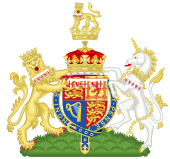
|

|
Prince Richard, Duke of Gloucester | Five-point label, the first, third and fifth points bearing a red cross, the second and fourth points bearing a red lion.[3] |

|

|
Prince Edward, Duke of Kent | Five-point label, the first, third and fifth points bearing a blue anchor, the second and fourth points bearing a red cross.[3] |

|

|
Princess Alexandra, The Hon. Lady Ogilvy | Five-point label, the first and fifth points bearing a red heart, the second and fourth points bearing a blue anchor, and the third bearing a red cross.[3] |
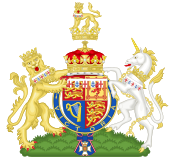
|

|
Prince Michael of Kent | Five-point label, the first, third and fifth points bearing a red cross, the second and fourth points bearing a blue anchor.[3] |
| Consorts | |||

|

|
Queen Camilla | The arms of the King impaled with those of Camilla's father, Major Bruce Shand, crowned with the royal crown.[47] |

|

|
Catherine, Princess of Wales | The arms of the Prince of Wales impaled with those of Catherine's father, Michael Middleton, crowned with the coronet of her husband as the heir apparent.[48] |

|

|
Meghan, Duchess of Sussex | The arms of the Duke of Sussex impaled with those of her own design, crowned with the coronet of a child of the sovereign.[49] |

|

|
Sophie, Duchess of Edinburgh | The arms of the Duke of Edinburgh impaled with those granted in 1999 to Sophie's father, Christopher Rhys-Jones, with remainder to his elder brother Theo. The new grant was based on an unregistered 200-year-old design. The lion alludes to one of the Duchess's ancestors, the Welsh knight Elystan Glodrydd, prince of Ferrig.[50] |

|

|
Birgitte, Duchess of Gloucester | The arms of the Duke of Gloucester with an escutcheon of pretence granted to her by Royal Warrant on 18 July 1973.[51] |
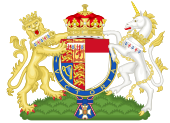
|

|
Katharine, Duchess of Kent | The arms of the Duke of Kent impaled with those of the Duchess's father, Sir William Worsley, 4th Baronet. |

|
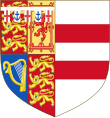
|
Princess Michael of Kent | The arms of Prince Michael of Kent impaled with those of Marie Christine's father, Baron Günther Hubertus von Reibnitz. |
-
Coat of arms of Albert, Prince Consort
-
Coat of arms of Prince Philip, Duke of Edinburgh
Government[edit]
Various versions of the royal arms are used by the Government of the United Kingdom, the Parliament of the United Kingdom and courts in some parts of the Commonwealth.
The UK Government generally uses a simplified version of the royal arms with a crown replacing the helm and crest, and with no compartment.[52] In relation to Scotland, the Scotland Office and the Advocate General for Scotland use the Scottish version, again without the helm or crest, and the same was used as the day-to-day logo of the Scottish Executive until September 2007, when a rebranding exercise introduced the name Scottish Government, together with a revised logo incorporating the flag of Scotland.[53] The Scottish Government continues to use the Arms on some official documents.
The simplified royal arms also feature:
- on all Acts of Parliament;
- on the cover of all UK passports and passports issued in other British territories and dependencies;
- as an inescutcheon on the diplomatic flags of British Ambassadors; and
- on all acts of the Anguilla House of Assembly, the Sovereign Base Areas, Pitcairn Islands and South Georgia and the South Sandwich Islands administrations;
- on The London Gazette.
Various courts in the Commonwealth also continue to use the royal arms:
- The Court of Appeal, Supreme Court and Provincial Court of British Columbia[54][55]
- The Supreme Court of Newfoundland and Labrador[56] and Court of Appeal of Newfoundland and Labrador[57]
- The Supreme Court of the Yukon Territory[58]
- The Supreme Court of South Australia[59]
- The Supreme Court of Victoria[60]
Furthermore:
- The crowned shield of the royal arms encircled by the Garter is used by the Home Office, by the Privy Council Office (United Kingdom), and by the Parliament of Victoria.[61]
- The crowned shield of the royal arms is used by the Royal Mint.
- The royal arms with the crest but without the helm is used as the rank insignia for Class 1 Warrant Officers in His Majesty's Armed Forces.
Use in Scotland[edit]
This table breaks down the official blazons to enable comparison of the differences between the general coat and the coat used in Scotland.
| Element | Description | Image |
|---|---|---|
| Quarterly I & IV | Or a lion rampant Gules armed and langued Azure within a double tressure flory-counter-flory of the second | |
| Quarterly II | Gules three lions passant gardant in pale Or armed and langued Azure | |
| Quarterly III | Azure a harp Or stringed Argent | |
| Surrounded by | The collar of the Order of the Thistle | |
| Crest | Upon the Royal helm the crown of Scotland proper, thereon a lion sejant affronté Gules armed and langued Azure, Royally crowned proper holding in his dexter paw a sword and in his sinister a sceptre, both proper |  |
| Supporters | Dexter a unicorn Argent Royally crowned proper, armed, crined and unguled Or, gorged with a coronet Or composed of crosses patée and fleurs de lis a chain affixed thereto passing between the forelegs and reflexed over the back also Or holding the standard of Saint Andrew, sinister a lion rampant gardant Or Royally crowned proper holding the standard of Saint George | |
| Motto | In My Defens God Me Defend, abbr. In Defens (Scots) | |
| Order Motto | Thistle: Nemo me impune lacessit (Latin) |  |
| Plants on the compartment | Thistles only |
See also[edit]
- Flag of the United Kingdom
- Cadency labels of the British royal family
- Armorial of the House of Plantagenet
- Arms of Canada - Canada's arms are closely modelled on the Royal Coat of Arms of the United Kingdom
- Coat of arms of Ireland - Ireland uses the medieval arms of Ireland that are incorporated into the Royal Coat of Arms of the United Kingdom
References[edit]
- ^ Berry, Ciara (15 January 2016). "Coats of arms". The Royal Family. The Royal Household. Retrieved 3 October 2020.
- ^ p. 10, Government identity system (2012). HM Government. "The Queen is Head of State, and the United Kingdom is governed by Her Majesty's Government in the name of the Queen. The royal coat of arms is personal to the Queen and..."
- ^ a b c d e f g h i j k l m n o p q r s t u v w Brooke-Little, J. P. (1978) [1950]. Boutell's Heraldry (Revised ed.). London: Frederick Warne LTD. pp. 205–222. ISBN 0-7232-2096-4.
- ^ "Royal Cypher - College of Arms".
- ^ "Traditions of the courts". Courts and Tribunals Judiciary. Retrieved 2 January 2017.
- ^ Justice (Northern Ireland) Act 2002 (c.26) 66 Display of Royal Arms at courts
- ^ "Identity guidelines" (PDF). HM Government. February 2022.
- ^ "Our Coins | The Royal Mint". www.royalmint.com. Archived from the original on 4 April 2008.
- ^ Treasures of Britain and Treasures of Ireland (1976 ed.). Drive Publications. p. 677. Retrieved 15 March 2014.
- ^ "Royal Arms in church". Intriguing History. 30 May 2013. Retrieved 31 July 2015.
- ^ Hasler, Charles (1980). The Royal Arms — Its Graphic And Decorative Development. Jupiter Books. ISBN 978-0904041200.
- ^ "The Courts of British Columbia - File Not Found". www.bccourts.ca.
- ^ Summers, Michael; Streeter, Ben (24 March 1997). "The strange case of Lady Thatcher and Her Majesty's coat of arms". The Independent. Retrieved 20 July 2017.
- ^ Hanley, Hugh (2015). "'The Last Shadow': Negotiating the Great Seal and Direct Access to the King, 1931". Irish Studies in International Affairs. 26. Royal Irish Academy: 257–274 : 266. doi:10.3318/isia.2015.26.13. JSTOR 10.3318/isia.2015.26.13. S2CID 156763438.; Walshe, Joseph (26 October 1937). "Memorandum on external seals". Documents on Irish Foreign Policy, Vol. V No. 97. Royal Irish Academy. Retrieved 20 September 2011.
- ^ heraldica.org. Heraldica. Retrieved 2 June 2020.
- ^ a b c d "The Franco-Scots Coinage of Mary Stuart and Francis II". Archived from the original on 26 February 2008.
- ^ Elizabeth and Mary, Royal Cousins, Rival Queens: Curators' Picks, British Library, 8 October 2021
- ^ "Yahoo | Mail, Weather, Search, Politics, News, Finance, Sports & Videos". www.yahoo.com.
- ^ Petchey, W.J., Massachusetts (1967). A Short Account of the Armorial Bearings of the Sovereigns of England. London: National Council of Social Service.
{{cite book}}: CS1 maint: multiple names: authors list (link) - ^ "April 1654: An Ordinance for uniting Scotland into one Commonwealth with England. | British History Online". www.british-history.ac.uk. Retrieved 10 January 2023.
- ^ Friar, Basic Heraldry (1993).
- ^ a b François Velde's Heraldica site
- ^ Arnaud Bunel's Héraldique européenne site[dead link]
- ^ British Royal Standards since 1801 David Prothero and Martin Grieve. Retrieved 13 May 2011.
- ^ a b c d e f g Cite error: The named reference
RHSCwas invoked but never defined (see the help page). - ^ a b "Symbols of the Governor General". Rideau Hall. Retrieved 21 November 2008.
- ^ a b "Ceremonial and Canadian Symbols Promotion – You were asking". Canadian Heritage. 24 September 2007. Archived from the original on 24 September 2008. Retrieved 21 November 2008.
- ^ "Royal Arms of Britain". Heraldica.org. Archived from the original on 6 December 2008. Retrieved 21 November 2008.
- ^ "The History of Heraldry in Canada". Royal Heraldry Society of Canada. 28 April 2004. Archived from the original on 6 March 2009. Retrieved 21 August 2008.
- ^ "Symbols of Canada" (PDF). Canadian Heritage. 2008. p. 9. Retrieved 20 November 2008.
- ^ a b Cite error: The named reference
LACwas invoked but never defined (see the help page). - ^ Cite error: The named reference
fraser2was invoked but never defined (see the help page). - ^ Cite error: The named reference
fraser1was invoked but never defined (see the help page). - ^ Cite error: The named reference
hansardwas invoked but never defined (see the help page). - ^ "The Canadian Heraldic Authority". Canadian Heraldic Authority. 27 September 2005 [updated 14 June 2006]. Retrieved 2 September 2008.
- ^ "The Constitution of the Order of Canada". Governor General of Canada. 6 December 2005. Archived from the original on 30 May 2011. Retrieved 21 November 2008.
- ^ a b Lamb, W. Kaye. "A Mari usque ad Mare". The Canadian Encyclopedia. Historica Foundation of Canada. Archived from the original on 17 August 2007. Retrieved 21 November 2008.
- ^ a b c d e Cite error: The named reference
descriptionwas invoked but never defined (see the help page). - ^ Andrew Chung (28 October 2007). "Time to herald our northern coast?". The Star. Toronto. Archived from the original on 13 October 2008. Retrieved 21 November 2008.
- ^ Deveau, Scott (3 September 2006). "From sea to sea to sea". Theglobeandmail.com. Archived from the original on 30 January 2012. Retrieved 21 November 2008.
- ^ CBC News (10 March 2006). "'To sea' or not 'to sea': that is the question". Cbc.ca. Retrieved 21 November 2008.
- ^ Lewis, Philippa; Darley, Gillian (1986). Dictionary of Ornament. Pantheon. ISBN 978-0394509310.
- ^ a b c d Moncreiffe, Iain; Pottinger, Don (1954). Simple Heraldry Cheerfully Illustrated. Thomas Nelson and Sons. pp. 40–41.
- ^ College of Arms. "College of Arms – the coat of arms of TRH Prince William and Prince Henry of Wales". Archived from the original on 27 May 2008. Retrieved 17 April 2010.
- ^ "Coat of Arms". Prince Harry. Clarence House. Archived from the original on 24 March 2016. Retrieved 12 April 2016.
- ^ "The Coat of Arms of HRH Prince Henry of Wales". College of Arms. Retrieved 10 December 2017.
- ^ "Camilla's coat of arms unveiled". BBC News. 17 July 2005.
- ^ "Coat of Arms of Duchess of Cambridge". dukeandduchessofcambridge.org. 14 November 2012. Archived from the original on 6 November 2012.
- ^ "Her Royal Highness The Duchess of Sussex: Coat of Arms". The Royal Family. 25 May 2018. Retrieved 25 May 2018.
- ^ Sophie's new coat. BBC News. 19 May 1999. Retrieved 14 November 2010.
- ^ Boutell, Charles; Brooke-Little, John Philip (1978). Boutell's Heraldry (8th revised ed.). Frederick Warne. p. 226. ISBN 9780723220961.
- ^ GOV.UK, Departments, agencies and public bodies [1]. Retrieved 10 August 2013
- ^ "New Lord Lyon King of Arms appointed". 5 March 2017. Archived from the original on 5 March 2017. Retrieved 29 July 2021.
- ^ "Court of Appeal – Hearing List". www.courts.gov.bc.ca.
- ^ "Provincial Court of British Columbia". www.provincialcourt.bc.ca.
- ^ "Supreme Court of Newfoundland and Labrador". court.nl.ca. Retrieved 29 July 2021.
- ^ "Home". Court of Appeal of Newfoundland and Labrador. Retrieved 29 July 2021.
- ^ "Supreme Court". www.yukoncourts.ca.
- ^ "SUPREME COURT ACT 1935 – SECT 15". www.austlii.edu.au.
- ^ "The Supreme Court of Victoria". www.supremecourt.vic.gov.au.
- ^ "Parliament of Victoria – Home". www.parliament.vic.gov.au.



